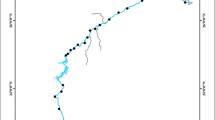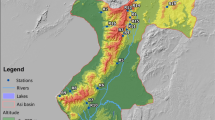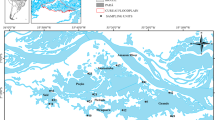Abstract
Diatom-based indices are increasingly becoming important tools for the assessment of ecological conditions in lotic systems. The applicability of regional and foreign diatom-based water quality assessment indices to streams around São Carlos-SP, Brazil, is discussed. The relationship between measured water quality variables and diatom index scores was assessed. The indices, when compared to chemical analyses, proved useful in providing an indication of the quality of the investigated waters. Though all borrowed indices were applicable to the study area because many widely distributed diatom species have similar environmental tolerances to those recorded for these species elsewhere, ecological requirements of some diatom species from Brazil need to be clarified and incorporated in a diatom-based water quality assessment protocol unique to the region.



Similar content being viewed by others
References
APHA, 1988. Standard Methods for the Examination of Water and Waste Water, 20th ed. American Public Health association, Washington, DC.
Azim, M. E., M. C. J. Verdegem, A. A. Van Dam & M. C. M. Bederidge (eds), 2005. Periphyton Ecology, Exploitation and Management. CABI Publishing, Cambridge.
Bate, G., P. Smailes & J. Adams, 2004. A water quality index for use with diatoms in the assessment. Water SA 30: 493–498.
Bere, T. & J. G. Tundisi, 2010. The effects of substrate type on diatom-based multivariate water quality assessment in a tropical river (Monjolinho), São Carlos-SP, Brazil. Water Air Soil Pollution 216: 391–409.
Bere, T. & J. G. Tundisi, 2011a. Influence of ionic strength and conductivity on benthic diatom communities in a tropical river (Monjolinho), São Carlos-SP, Brazil. Hydrobiologia 661: 261–276.
Bere, T. & J. G. Tundisi, 2011b. Influence of land-use patterns on benthic diatom communities and water quality in the tropical Monjolinho hydrological basin, São Carlos-SP, Brazil. Water SA 37: 93–102.
Bicudo, C. E. M. & M. Menezes, 2006. Gêneros de água de águas continentais do Brazil: chave para identificação e descrições. Rima Editora, São Carlos, SP, Brazil: 391–339.
Biggs, B. J. F. & C. Kilroy, 2000. Stream Periphyton Monitoring Manual. NIWA, Christchurch, New Zealand.
Cemagref, 1982. Etude des methods biologiques d’appréciation quantitative de la qualité des eaux. Rapport Q. E. Lyon, Agence de l’eau Rhône-Méditerranée-Corse-Cemagref, Lyon, France.
Coste, M. & H. Ayphassorho, 1991. Étude de la qualité dês eaux du Bassin Artois-Picardie à l’aide des communautés de diatomées benthiques (application des índices diatomiques). Rapport Cemagref. Bordeaux – Agence de l’Eau Artois-Picardie, Douai.
Dell’Uomo, A., 1996. Assessment of water quality of an Apennine river as a pilot study. In Whitton, B. A. & E. Rott (eds), Use of Algae for Monitoring Rivers II. Institut für Botanik, Universität Innsbruck, Innsbruck: 65–73.
Descy, J. P., 1979. A new approach to water quality estimation using diatoms. Nova Hedwigia 64: 305–323.
Descy, J. P. & M. Coste, 1991. A test of methods for assessing water quality based on diatoms. Verhandlungen der Internationalen Vereinigung für Theoretische und Angewandte Limnologie 24: 2112–2116.
Dionex Corporation, 2001. Dionex DX-80 Ion Analyzer Operator’s Manual. Dionex Corporation, USA.
Duong, T., Coste, M., Feurtet-mazel, A., Dang, D., Gold, C., Park, Y. et al, 2006. Impact of urban pollution from the Hanoi area on benthic diatom communities collected from the Red, Nhue and Tolich Rivers (Vietnam). Hydrobiologia 563:201–216.
Gómez, N. & M. Licursi, 2001. The Pampean Diatom Index (IDP) for assessment of rivers and streams in Argentina. Aquatic Ecology 35: 173–181.
Hammer, O., D. A. T. Harper & P. D. Ryan, 2009. PAST – Palaeontological Statistics, Version 1.90. http://folk.uio.no/ohammer/past.
Harding, W. R., C. G. M. Archibald & J. C. Taylor, 2005. The relevance of diatoms for water quality assessment in South Africa: a position paper. Water SA 31: 41–46.
Kelly, M. G. & B. A. Whitton, 1995. The trophic diatom index: a new index for monitoring eutrophication in rivers. Journal of Applied Phycology 7: 433–444.
Kelly, M. G., C. J. Penny & B. A. Whitton, 1995. Comparative performance of benthic diatom indices used to assess river water quality. Hydrobiologia 302: 179–188.
Kilham, P., S. S. Kilham & R. E. Hecky, 1986. Hypothesized resources relationships among African plankton diatoms. Limnology and Oceanography 31: 1169–1181.
Kobayasi, H. & S. Mayama, 1989. Most pollution-tolerant diatoms of severely polluted rivers in the vicinity of Tokyo. Japanese Journal of Phycology 30: 188–196.
Krammer, K. & H. Lange-Bertalot, 1986–1991. Süßwasserflora von Mitteleuropa. Band 2. Bacillariophyceae. Teil 1–4. Gustav Fischer, Stuttgart, Germany.
Kwandrans, J., P. Eloranta, B. Kawecka & W. Kryzsysztof, 1998. Use of benthic diatom communities to evaluate water quality in rivers of southern Poland. Journal of Applied Phycology 10: 193–201.
Lange-Bertalot, H., 1979. Pollution tolerance of diatoms as a criterion for water quality estimation. Nova Hedwigia Beiheft 64: 285–304.
Leclerq, L. & B. Maquet, 1987. Deux nouveaux índices chimique et diatomique de qualité d’eau courante. Application au Samson et à ses affluents (bassin de la Meuse belge). Comparaison avec d’autres índices chimiques, biocé notiques et diatomiques. Institut Royal des Sciences Naturelles de Belgique, document de travail 28.
Lecointe, C., M. Coste & J. Prygiel, 1993. “Omnidia”: software for taxonomy, calculation of diatom indices and inventories management. Hydrobiology 269(270): 509–513.
Lenoir, A. & M. Coste, 1996. Development of a practical diatom index of overall water quality applicable to the French National Water Board network. In Whitton, B. A. & E. Rott (eds), Use of Algae for Monitoring Rivers II. Institut für Botanik, Universität Innsbruck, Innsbruck: 29–43.
Lobo, E. A. & V. L. Callegaro, 2000. Avaliação da qualidade de águas doces continentais com base em algas diatomáceas epilíticas: Enfoque metodológico. In Tucci, C. E. M. & D. M. Marques (eds), Avaliação e Controle da Drenagem Urbana. Ed. Universidade/UFRGS, Porto Alegre: 277–300.
Lobo, E. A. & L. C. Torgan, 1988. Análise da estrutura da comunidade de diatomáceas (Bacillariophyceae) em duas estações do sistema Guaíba, RS, Brasil. Acta Botânica Brasílica 1: 103–119.
Lobo, E. A., M. A. Oliveira, M. T. Neves & S. Schuler, 1991. Caracterização de ambientes de terras úmidas, no Estado do Rio Grande do Sul, onde ocorrem espécies de anatídeos com valor cinegético. Acta Biológica Leopoldensia 13: 19–60.
Lobo, E. A., V. L. M. Callegaro, M. A. Oliveira, S. E. Salomoni, S. Schuler & K. Asai, 1996. Pollution tolerant diatoms from lotic systems in the Jacui Basin, Rio Grande do Sul, Brasil. Iheringia Série Botânica 47: 45–72.
Lobo, E. A., D. A. Bem, A. Costa & A. Kirst, 1999. Avaliação da qualidade da água dos arroios Sampaio, Bonito e Grande, Município de Mato Leitão, RS, Brasil, segundo a resolução do CONAMA 20/86, Vol. 4. Revista Redes, Santa Cruz do Sul: 129–146.
Lobo, E. A., V. L. Callegaro & P. Bender, 2002. Utilização de algas diatomáceas epilíticas como indicadoras da qualidade da água em rios e arroios da Região Hidrográfica do Guaíba, RS. EDUNISC, Santa Cruz do Sul, Brasil.
Lobo, E. A., V. L. Callegaro, G. Hermany, D. Bes, C. E. Wetzel & M. A. Oliveira, 2004. Use of epilithic diatoms as bioindicator from lotic systems in southern Brazil, with special emphasis on eutrophication. Acta Limnologica Brasiliensia 16: 25–40.
McCormick, P. V. & J. J. Cairns, 1994. Algae as indicators of environmental change. Journal of Applied Phycology 6: 509–526.
Metzeltin, D. & H. Lange-Bertalot, 1998. Tropical diatoms of South America I. Iconographia Diatomologica 5: 1–695.
Metzeltin, D. & H. Lange-Bertalot, 2007. Tropical diatoms of South America II. Iconographia Diatomologica 18: 1–877.
Metzeltin, D., H. Lange-Bertalot & F. García-Rodríguez, 2005. Diatoms of Uruguay. Iconographia Diatomologica 15: 1–736.
Moreles, E. A. & A. Jasinski, 2002. Morphological studies in Gomphonema parvulum complex: evidence of cryptic species? In 17th International Diatom Symposium, Ottawa, Canada, 25–31 August, 2002, Book of Abstracts: 90 pp.
Pan, Y., R. J. Stevenson, B. H. Hill, A. T. Herlihy & G. B. Collins, 1996. Using diatoms as indicators of ecological conditions in lotic systems: a regional assessment. Journal of North American Benthological Society 15: 481–495.
Pappas, J. L. & E. F. F. Stoermer, 1996. Quantitative method for determining a representative algal sample count. Journal of Phycology 32: 693–696.
Pipp, E., 2002. A regional diatom-based trophic state indication system for running water sites in Upper Austria and its overregional applicability. Verhandlungen der Internationalen Vereinigung für Theoretische und Angewandte Limnologie 27: 3376–3380.
Potapova, M. G. & D. F. Charles, 2002. Benthic diatoms in USA Rivers: distributions along speciation and environmental gradients. Journal of Biogeography 29: 167–187.
Potapova, M. & D. F. Charles, 2003. Distribution of benthic diatoms in U.S. rivers in relation to conductivity and ionic composition. Freshwater Biology 48: 1311–1328.
Potapova, M. & D. F. Charles, 2005. Choice of substrate in algae-based water quality assessment. Journal of North American Benthological Society 24: 415–427.
Prygiel, J. & M. Coste, 1993. The assessment of water quality in the Artois-Picardie water basin (France) by the use of diatom indices. Hydrobiologia 269(279): 343–349.
Prygiel, J., L. Lévéque & R. Iserentant, 1996. Un nouvel indice diatomique pratique pour l’évaluation de La qualité des eaux en réseau de surveillance. Revue dês Sciences de l’Eau 1: 97–113.
Prygiel, J., B. A. Whitton & J. Bukowska, 1999. Use of Algae for Monitoring Rivers III. Agence de L’Eau Artois-Picardie, Douai: 271 pp.
Rimet, F., H. M. Cauchie, L. Hoffmann & L. Ector, 2005. Response of diatom indices to simulated water quality improvements in a river. Journal of Applied Phycology 17: 119–128.
Rocha, A. A., 1992. Algae as indicators of water pollution. In Cordeiro-Marino, M., M. T. P. Azevedo, C. L. Sant’anna, N. Y. Tomita & E. M. Pastino (eds), Algae and Environment: A General Approach. Sociedade Brasileira de Ficologia, CETESB, São Paulo: 34–55.
Rodrigues, L. M. & E. A. Lobo 2000. Análise da estrutura de comunidades de diatomáceas epilíticas no Arroio Sampaio, Município de Mato Leitão, RS, Brasil, Vol. 2. Caderno de Pesquisa Série Botânica, Santa Cruz do Sul: 5–27.
Rosa, Z. M., L. C. Torgan & L. A. W. Herzog, 1988. Análise da estrutura de comunidades fitoplanctônicas e de alguns fatores abióticos em trecho do Rio Jacuí, Rio Grande do Sul, Brasil. Acta Botanica Brasilica 2: 31–46.
Rott, E., G. Hofmann, K. Pall, P. Pfister & E. Pipp, 1997. Indikationslisten für Aufwuchsalgen. Teil 1. Saprobielle Indikation. Bundesministerium für Land- und Forstwirtschaft, Wien: 1–73.
Rott, E., E. Pipp, P. Pfister, H. van Dam, K. Ortler, N. Binder & K. Pall, 1999. Indikationslisten für Aufwuchsalgen in ö sterreichischen Fliessgewä ssern. Teil 2: Trophieindikation (sowie geochemische Pra¨ferenzen; taxonomische und toxikologische Anmerkungen). Wasserwirtschaftskataster herasgegeben vom Bundesministerium f. Land- u.Forstwirtschaft, Wien. ISBN 3-85 174-25-4: 248 pp.
Rott, E., E. Pipp & P. Pfister, 2003. Diatom methods developed for river quality assessment in Austria and a cross-check against numerical trophic indication methods used in Europe. Algological Studies 110: 91–115.
Round, F. E., 1991. Diatoms in river water-monitoring studies. Journal of Applied Phycology 3: 129–145.
Round, F. E., 2004. pH scaling and diatom distribution. Diatom Research 20: 9–12.
Salomoni, S. E., O. Rocha, V. L. Callegaro & E. A. Lobo, 2006. Epilithic diatoms as indicators of water quality in the Gravataí river, Rio Grande do Sul, Brazil. Hydrobiologia 559: 233–246.
Schiefele, S. & C. Schreiner, 1991. Use of diatoms for monitoring nutrient enrichment acidification and impact salts in Germany and Austria. In Whitton, B. A., E. Rott & G. Friedrich (eds), Use of Algae for Monitoring Rivers. Institüt für Botanik, Universität Innsbruck, Innsbruck.
Slàdeček, V., 1986. Diatoms as indicators of organic pollution. Acta Hydrochimica et Hydrobiologica 14: 555–566.
Souza, M. G. M., 2002. Variação da comunidade de diatomáceas epiliticas ao longo de um rio impactado no município de São Carlos – SP e sua relação com variáveis fiscas e químicas. Tese (Doutorado e Ciências Biológicas) Ecologia a Recursos Naturais, Universidade Federal de São Carlos, São Carlos, SP, Brasil.
Stevenson, R. J., M. L. Bothwell & R. L. Lowe, 1996. Algal Ecology—Freshwater Benthic Ecosystems. Academic Press, San Diego: 750 pp.
Taylor, J. C., M. C. Janse Van Vuuren & A. J. H. Pieterse, 2007a. The application and testing of diatom-based indices in the Vaal and Wilge Rivers, South Africa. Water SA 33: 51–59.
Taylor, C. J., A. V. Prygiel, P. A. De La Rey & S. Van Rensburg, 2007b. Can diatom-based pollution indices be used for biological monitoring in SA? A case study of the Crocodile West and Marico water management area. Hydrobiologia 592: 455–464.
Trobajo, R., E. Clavero, V. A. Chepurnov, K. Sabbe, D. G. Mann, S. Ishihar & E. J. Cox, 2009. Morphological, genetic and mating diversity within the widespread bioindicator Nitzschia palea (Bacillariophyceae). Phycologia 48: 443–459.
Van Dam, H., A. Mertens & J. Sinkeldam, 1994. A coded checklist and ecological indicator values of freshwater diatoms from the Netherlands. Aquatic Ecology 28: 117–133.
Watanabe, T., K. Asai & A. Houki, 1986. Numerical estimation of organic pollution of flowing waters by using the epilithic diatom assemblage – Diatom Assemblage Index (DIApo). Science of the Total Environment 55: 209–218.
Watanabe, T., K. Asai & A. Houki, 1988. Numerical water quality monitoring of organic pollution using diatom assemblages. In Round, F. E. (ed.), Proceedings of the Ninth International Diatom Symposium. Koeltz Scientific Books, Koenigstein, Germany: 123–141.
Wehr, J. D. & R. G. Sheath, 2003. Freshwater Algae of North America, Ecology and Classification. Academic Press, San Diego, CA, USA: 918 pp.
Zelinka, M. & P. Marvan, 1961. Zur prasisiering der biologischen klassifikation der reinheot fliessender gewässer. Archive Hydrobiologia 57: 389–407.
Author information
Authors and Affiliations
Corresponding author
Additional information
Handling editor: Luigi Naselli-Flores
Rights and permissions
About this article
Cite this article
Bere, T., Tundisi, J.G. Applicability of borrowed diatom-based water quality assessment indices in streams around São Carlos-SP, Brazil. Hydrobiologia 673, 179–192 (2011). https://doi.org/10.1007/s10750-011-0772-7
Received:
Revised:
Accepted:
Published:
Issue Date:
DOI: https://doi.org/10.1007/s10750-011-0772-7




